|
UNITED PRINCIPALITIES OF
ROMANIA |
|
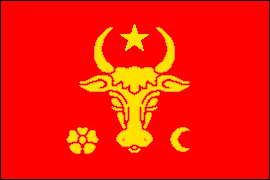
Principality of Moldavia |
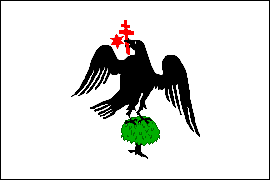
Principality of Wallachia |
|
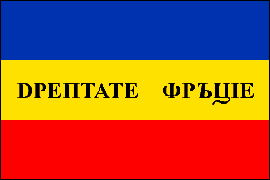 |
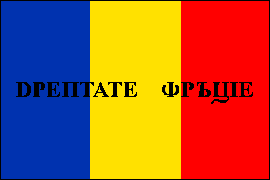
|
|
Wallachia
• Flags of the 1848 Revolution |
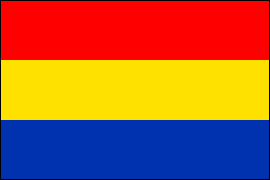
United Principalities of
Romania •
National Flag • 1859-66 |
|
Numerous flags and banners are associated with Moldavia and
Wallachia; the two shown above were used in the late eighteenth and
early nineteenth centuries. The state and princely flag of Moldavia
was a banner of the princely coat of arms, whose principal charge
was the head of an ox. Variants of this flag existed, e.g. a naval
ensign with the charges in white instead of yellow. The black eagle
or raven was long associated with Wallachia, usually being depicted
standing on a juniper branch and holding in its beak a two-barred
cross. The various raven flags with red, blue and white fields were
adapted from the princely arms. The variant depicted above was known
to be in used in the eighteenth century.
In 1848 Wallachia rose in revolt
against the Ottoman Empire. The provisional revolutionary government
adopted a horizontal tricolor of blue, yellow and red. n the yellow
stripe appeared the words Justice and Brotherhood in
Wallachian and Moldavian characters respectively. Why the colors
blue, yellow and red were chosen is not entirely clear but they did
figure in the design of past military flags and princely banners.
The arrangement of the stripes was later changed from horizontal to
vertical. When the two principalities were joined in personal union
in 1859 the horizontal tricolor with red uppermost was made the
national flag. |
KINGDOM OF ROMANIA |
|
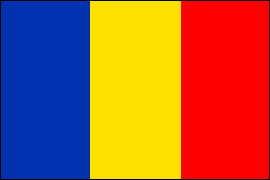
National Flag & Civil Ensign
• 1866-1947 |
|
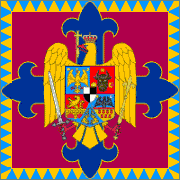
Royal Standard •
1922-47 |
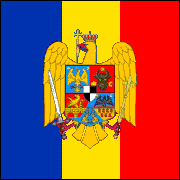
Standard of Marshal Ion
Antonescu •
1940-45 |
|
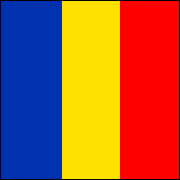
Ministers of the Government |
|
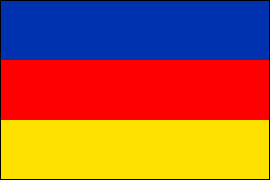
Transylvania •
1765-1918 |
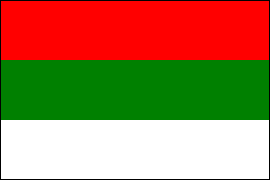
Transylvania •
Independence Flag • 1918 |
|
The United Principalities of Romania adopted the vertical
blue-yellow red tricolor as its national flag in 1866. This flag was
retained when Romania became a kingdom in 1881, the new constitution
specifying the plain blue-yellow-red tricolor as the national flag
and civil ensign. The tricolor with the full achievement of the royal
coat of arms on the yellow stripe was specified as the war flag,
naval ensign and royal flag. In 1922, however, the royal flag
depicted above was adopted; it displayed the lesser royal arms. This
coat of arms quarters the arms of Wallachia, Moldavia, Banat-Oltenia
and Transylvania
with the arms of
Dobruja at the point and an escutcheon of the arms of the royal
House of
Hohenzollern-Sigmaringen.
Ministers of the government other than the Minister of War were
entitled to display a square tricolor. The standard of the Romanian
dictator, Marshal Ion Antonescu, was made in Germany on the
occasion of his official visit to that country in 1940.
At the end of the Great War in 1918 the former
Austro-Hungarian provinces of
Transylvania, Banat and
Bukovina and the former Russian province of Bessarabia, all of which
had substantial Romanian populations, were annexed by Romania. Many
variants of the Romanian tricolor, including the traditional
horizontal blue-red yellow flag of Transylvania, appeared at this
time. The Transylvanian flag dated from the mid-eighteenth century
but was never official, such manifestations of nationalism being
outlawed by the Hungarian authorities. Transylvania was briefly
independent between October and December 1918 and during that time a
horizontal red-green-white flag was apparently used. |
PEOPLE'S REPUBLIC OF ROMANIA
• SOCIALIST REPUBLIC OF ROMANIA |
|
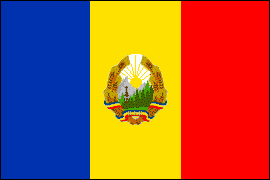
People's Republic of Romania
• National Flag •
1947-51 |
|

People's Republic of Romania
National Flag •
1951-65 |
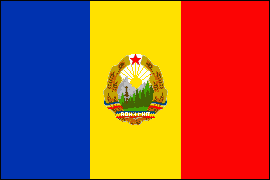
Socialist Republic of Romania
National Flag •
1965-89 |
|
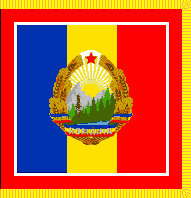
Socialist Republic of Romania
• Presidential Flag •
1965-89 |
|
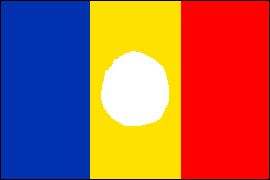
Flag of the 1989 Revolution |
|
In 1947 the monarchy was abolished and Romania became a People's
Republic. The new state coat of arms, a typical example of communist
heraldry, was placed on the yellow stripe of the national flag. The
initials of the state appeared on the tricolor ribbon. These arms
were amended in 1951 by the addition of a red star for communism and
they were changed again in 1965 when the name of the state was
changed to the Socialist Republic of Romania. The presidential flag
used from 1965 to 1989 was a square, fringed version of the state
flag within a white/red frame.
In 1989 widespread unrest led to
an uprising against the despotic regime of President Nicolae
Ceaușescu.
As a
gesture of defiance, rebels tore the communist arms from the state
flag and this "flag with a hole" became the symbol of the revolution
that overthrew the communist regime. |
|
REPUBLIC OF ROMANIA |
|

National Flag &
Ensign |
|
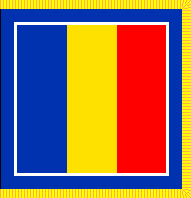
Presidential Flag |
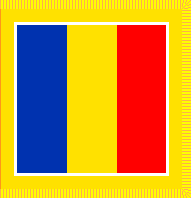
Prime Minister's Flag |
|
Following the 1989 revolution,
Romania readopted the plain blue/yellow/red tricolor as its national
flag. Because of its similarity to the national flag of Chad there
have been proposals to modify the Romanian flag by adding the state
coat of arms, which resemble the royal arms used from 1922 to 1947
but so far nothing has come of this. The president and prime
minister of the republic have square, fringed standards. Versions
without fringe also exist for use at sea.
|

















